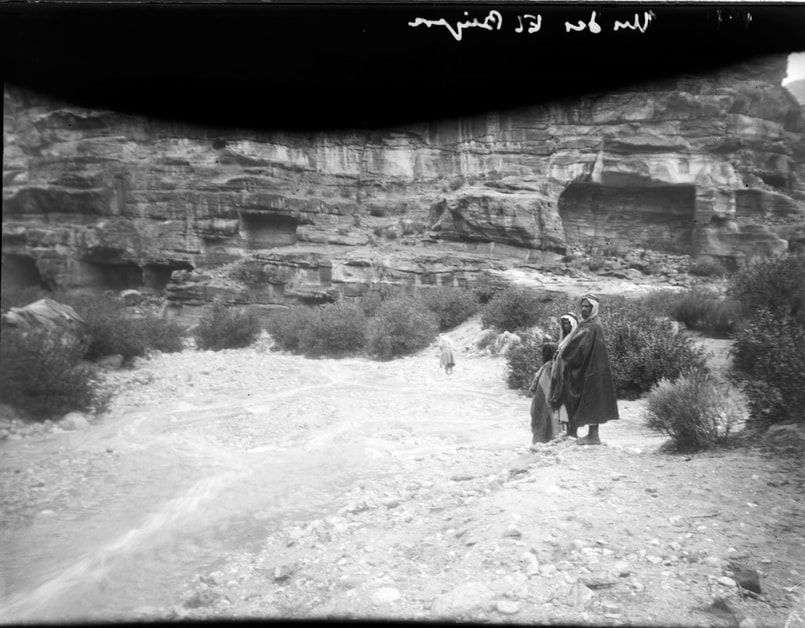|
[by Agnes Conway] A. C. No dig today as it poured with rain and Mr. Horsfield sorted pots, and A.E.C. welcomed the chance of reading. At lunch-time there was a shout of water in the Wadi Musa, and the whole camp rushed to see it pouring into the Siyagh. It was, however, coming from the Metaha and not from the Sik at that time; so Mr H. and A.E.C. went to examine the large buildings under El Hubta. The enormous façade next but one N. of the Tomb of the Urn has only 2 small but perfectly squared or tooled rooms, one of which seemed to ring hollow in the middle of the floor and may be worth clearing out. The next two at right angles to each other, have no facades and may be houses. The Corinthian Tomb has capitals almost Byzantine, combined with triglyphs and dentals of yellow stone painted with stripes of black. It was impossible to tell whether the inserted stone of the low arches on the left was plastered or not. Inside the Palace Tomb the arrangement of 4 bases for sarcophagi 1, on a high shelf in a niche, was odd and unique in Petra. The colour of this ceiling and the neighbouring one on the left was superb in the greyish light; a fantastic palette of blood red, orange, pink, grey, pale mauve, and silver, set off by great black splotches from the Bedouin fires. As soon as the sun shone the colour paled. This English day of thunderclouds, and snatches of deep blue sky brought out all the colour of the rocks and intensified the green. A blinding hail storm was difficult to battle against on the way home. We jumped the Wady Musa and got to camp a few minutes before the Deir Wady became a raging torrent, cutting off the 2 sides of the camp from each other, and threatening the tents, around which trenches had to be dug at once. Before supper the stream was dry again. __ [Footnote] 1. The same seen later near right [? In pencil] of Tomb of Urn Reference: Conway, A. 1929 (transcribed by A. Thornton). Petra Exploration Fund Diary. "Business Papers to be Kept", Horsfield Collection Box 8, UCL Institute of Archaeology, 21 April: 48-49. [by George Horsfield and possibly Agnes Conway] G. H. No. 2 cave continues being cleared in the inner room which has gone more rapidly. No. 3. is cleared except for the floor – a bench of stone about 80 cents. wide existed on right side apparently running the whole length. There is a channel in rear wall to fix it in. The niche at back proves to be only 45 cents deep – purpose unknown. No more pottery. Began to dig two shaft tombs on Ma’aisera plateau – one was entered from a hole on a corner without touching shaft – Byzantine pottery fragments and nothing else so far. This No. 2. The other shaft No. 1. was filled to the brim with earth. This being cleared to 1 metre disclosed side chamber. On entering found about 10 skulls in disorder on the floor, a mass of bones – 2 pots in a corner – another near a corpse on right side and a Byzantine pot. A lot of pots came out of the shaft – including base of Rabbit Thyton with stone metal eyes – the head of a female with a hook nose – an open mouth and a crescent moon bound on her forehead. Small pots, lamps etc. A.E.C. climbed El Biyara in the morning, passing a terrace with 3 Dushara niches (given by Dalman as a sanctuary) and then going by two great inclined planes in the rock like the entrance to El Hubta. Above these, right out in the open, is a charming country house of two rooms and a terrace, with a superb view. Steps go all the way to the top, which is a long flat plateau with remains of squared stone ruins all over it, flat with the ground. I could not date them at all. The surface pottery is Byzantine, Greco-Roman, and some very rough stuff, possibly bronze age? There are six enormous cisterns; large round openings in the ground, going down deep and with stones, in some cases squared, that have fallen in from the top. Near the Arabah side of the hill and close up against another hill for shelter, is a rounded topped cave with an early plain door; date unknown. The whole hill was evidently a fastness [sic], and commands the whole country; the views are superb. The easy route from Elji to El Barid is clearly visible and the spur from it that would lead to the Edomite High Place – the first ridge of El Ma’aisera is seen absolutely crammed with buildings, the other ridges by contrast, looking quite empty. A big quarried valley seemed to lead N out of the Siyagh; the last course of the Wady Musa, through black spiky rocks, looked magnificent. Reference: Horsfield, G. [and possibly Conway, A.] 1929 (transcribed by A. Thornton). Petra Exploration Fund Diary. "Business Papers to be Kept", Horsfield Collection Box 8, UCL Institute of Archaeology, 23 April: 52-53.
|
Categories
All
Archives |

 RSS Feed
RSS Feed